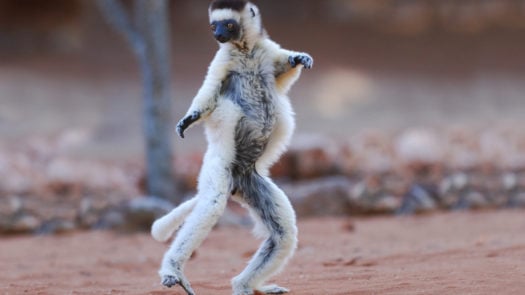Published on: March 2nd, 2020
Last updated: July 27th, 2023
An utterly unique island, the remote Madagascar has started to emerge as a fascinating wildlife destination.
From seeing ‘dancing lemurs’ to spotting the elusive Madagascan red owl, there’s a myriad of wildlife-centred activities on offer in Madagascar.
To help you make the most of wildlife spotting opportunities on your next trip, this is our experts’ guide to wildlife in Madagascar.
1) Sifaka lemurs
Perhaps one of Madagascar’s most famous endemic wildlife species, lemurs are synonymous with this African island. Their name comes from the Roman word lemures, translating to ghosts – relating to their slow habits and nocturnal nature. Whilst there are nearly 100 species of lemur in Madagascar, the arresting sifaka lemurs are one of the most interesting. Nicknamed the dancing lemur, these interesting creatures have white bodies, black faces, slightly webbed hands and very long tails. As this primate spends most of its time prancing through the trees, the only way it knows how to get around on solid ground is by leaping – hence, the dancing lemur.
2) Fossa
An eclectic mix between a small dog and a large cat, the fossa is Madagascar’s largest mammalian carnivore. They mainly feast on lemurs, and they can sometimes be found rummaging through bins for scraps. They’re mostly found in Kirindy Reserve, a verdant forest-filled reserve close to the mid-west coast. These carnivorous creatures are hard to miss, as they tend to wander through camps to forage for food, so you’re likely to get really close up views. In November, the fossa population engages in a captivating mating ritual, which involves the female letting out a call from a branch. When a male approaches, if she doesn’t approve of him she simply moves closer to the end of the branch, working to the principle that the heavier males would snap the branch if they moved closer.
3) Indri
Revered as sacred animals by many of the local Malagasy people, indri bears are a common feature of local legends. The largest of all lemurs, these mesmerising mammals can grow up to 120 centimetres (3.9 feet) with their legs fully extended. Their most arresting feature is their loud, distinctive calls that ring out through the treetops. Found in the eastern Andasibe National Park, this endemic species has been habituated to humans, so you can get close-up views and some excellent photographs.
4) Kestrels
A small but mighty bird of prey, the Madagascan kestrel has been around for almost a million years. Found throughout Madagascar in almost all habitats except thick forest, this elusive bird of prey can be hard to track down. Conspicuous in towns and villages, these golden birds often nest on buildings and spend much of their time hovering in various parts of the city. Although they’re hard to track down, if you do manage a sighting of one, you’re sure to be captivated by their golden feathers and piercing eyes.
5) Ring-tailed lemurs
Ring-tailed lemurs are the most iconic animal to inhabit Madagascar, and they are instantly recognisable with their long black and white tails. They’re also the easiest lemur to see up close, as they spend most of their time on the ground. These primates fear no one, and as a result they’re extremely friendly creatures. During the summer months, their mating call fills the air and from August to September, you can see mothers with young clinging to their stomachs. Mostly found in the south, the Ifotaka Community Forest is one of the best places to track them. Alternatively, venture further afield from Andasibe to Lemur Island, where they’re far tamer and may climb on to your shoulders in search of food.
6) Chameleons
In Madagascar, chameleons come in all shapes and sizes – from the 60 centimetre (24 inch) Outsalets and Parsons chameleons to the miniscule pygmy stump-tailed chameleon, which is no longer than a fingernail. Although it’s thought that chameleons change colour in order to camouflage, they actually change their hue in order to communicate their emotions. You can find species in most parts of Madagascar, but you have more chance of seeing them at night, when they turn almost white in colour.
7) Madagascan red owls
Similar to barn owls, the Madagascar red owl has a distinctly similar screeching call but is slightly smaller with a reddish-orange hue. Classed as ‘vulnerable,’ this species is under pressure from habitat loss, but this is an improvement on its previous ‘endangered’ classification, so things are looking up. These animals mostly stick to the humid evergreen forest in the east and north of Madagascar, and can be tracked down in places like Amber Mountain National Park. As they’re nocturnal creatures, they can be tricky to spot – so heading out on a night walk with a guide gives you the best chance of seeing or hearing one.
Discover Madagascar's wildlife
Feeling inspired? Our expert travel designers are always on hand to help you plan your next wildlife-focused adventure through Madagascar.












